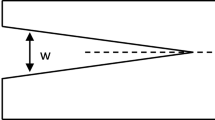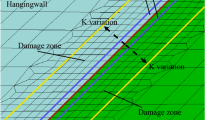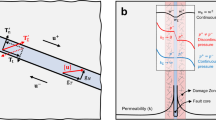Abstract—Numerical modeling of induced seismicity resulting from fluid injection into the subsurface is considered. One of important factors determining the slip dynamics of a tectonic fault during fluid injection loading is the form of the law of friction acting on the fault sides. The numerical analysis in the context of a slider model compared to the results of laboratory experiments has shown that a two-parameter rate-and-state friction law describes the widest spectrum of the observed sliding modes. A double porosity model and a slider model for fracture are used to simulate the induced seismicity in the region of Basel, Switzerland, caused by geothermal stimulation. A physically complete model of embedded fractures which allows for calculating fluid flow in a rock with fractures or faults taking into account changes in the hydraulic properties of the latter is presented. Fault deformation process is described based on the displacement discontinuity method. Based on the model, the results of the field experiment on water injection into a fault in the southern France are analyzed. The development of fault slips is studied as a function of a number of parameters characterizing a fault, filtration properties of a rock, and injection pattern. The conditions for the emergence of seismic slip in the context of the proposed model are established.



















Similar content being viewed by others
REFERENCES
Adushkin, V.V. and Turuntaev, S.B., Tekhnogennaya seismichnost’ – indutsirovannaya i triggernaya (Manmade Seismicity: Induced and Triggered), Moscow: IDG RAN, 2015.
Baisch, S., Voros, R., Rothert, E., Stang, H., Jung, R., and Schellschmidt, R., A numerical model for fluid injection induced seismicity at Soultz-sousForets, Int. J. Rock Mech. Min. Sci., 2010, vol. 47, no. 3, pp. 405–413.
Bommer, J.J., Oates, S., Cepeda, J.M., Lindholm, C., Bird, J.F., Torres, R., Marroquín, G., and Rivas, J., Control of hazard due to seismicity induced by a hot fractured rock geothermal project, Eng. Geol., 2006, vol. 83, no. 4, pp. 287–306.
Budkov, A.M. and Kocharyan, G.G., Experimental study of different modes of block sliding along interface. Part 3. Numerical modeling, Phys. Mesomech., 2017, vol. 20, no. 2, pp. 203–208. https://doi.org/10.1134/S1029959917020102
Budkov, A.M., Kocharyan, G.G., Novikov, V.A., and Krasheninnikov, A.V., Modification of the empirical rate-and-state friction law for modeling slow slip events, in Sb. nauchn. tr. IDG RAN: Dinamicheskie protsessy v geosferakh, vyp. 7 (Collect. Pap. IDG RAS: Dynamic Processes in Geospheres, vol. 7), Moscow: GEOS, 2015, pp. 22–30.
Cappa, F., Guglielmi, Y., Nussbaum, C., and Birkholzer, J., On the relationship between fault permeability increases, induced stress perturbation, and the growth of aseismic slip during fluid injection, Geophys. Res. Lett., 2018, vol. 45, no. 11, pp. 11–20.
Carpenter, B.M., Scuderi, M.M., Collettini, C., and Marone, C., Frictional heterogeneities on carbonate-bearing normal faults: Insights from the Monte Maggio Fault, Italy, J. Geophys. Res.: Solid Earth, 2014, vol. 119, no. 12, pp. 9062–9076.
Carpenter, B.M., Saffer, D.M., and Marone, C., Frictional properties of the active San Andreas Fault at SAFOD: Implications for fault strength and slip behavior, J. Geophys. Res.: Solid Earth, 2015, vol. 120, no. 7, pp. 5273–5289.
Diechmann, N., Kraft, T., and Evans, K.F., Identification of faults activated during the stimulation of the Basel geothermal project from cluster analysis and focal mechanics of the larger magnitude events, Geothermics, 2014, vol. 52, pp. 84–97. https://doi.org/10.1016/j.geothermics.2014.04.001
Dieterich, J.H., Modeling of rock friction: 1. Experimental results and constitutive, J. Geophys. Res., 1979, vol. 84, no. B5, pp. 2161–2168.
Dinske, C., Interpretation of fluid induced seismicity and hydrocarbon of Basel and Cotton Valley, Dissertation zur Erlangung des akademischen Grades Doktor der Naturwissenschaften, Berlin: Freien Universität Berlin, 2011. https://doi.org/10.17169/refubium-15993
Ellsworth, W., Llenos, A., McGarr, A., Michael, A., Rubinstein, J., Mueller, C., Petersen, M., and Calais, E., Increasing seismicity in the U.S. midcontinent: Implications for earthquake hazard, Leading Edge, 2015, vol. 34, no. 6, pp. 618–626. https://doi.org/10.1190/tle34060618.1
Ellsworth, W.L., Giardini, D., Townend, J., Ge, S., and Shimamoto, T., Triggering of the Pohang, Korea, earthquake (M w 5.5) by enhanced geothermal system stimulation, Seismol. Res. Lett., 2019, vol. 90, no. 5, pp. 1844–1858. https://doi.org/10.1785/0220190102
Erickson, B., Birnir, B., and Lavallée, D., A model for aperiodicity in earthquakes, Nonlin. Processes Geophys., 2008, vol. 15, pp. 1–12. https://doi.org/10.5194/npg-15-1-2008
Gischig, V.S. and Wiemer, S., A stochastic model for induced seismicity based on non-linear pressure diffusion and irreversible permeability enhancement, Geophys. J. Int., 2013, vol. 194, no. 2, pp. 1229–1249.
Gu, J.-C., Rice, J.R., Ruina, A.L., and Tse, S.T., Slip motion and stability of a single degree of freedom elastic system with rate and state dependent friction, J. Mech. Phys. Solids, 1984, vol. 32, no. 3, pp. 167–196.
Guckenheimer, J. and Holmes, P., Nonlinear Oscillations, Dynamical Systems, and Bifurcations of Vector Fields, 1st ed., New York: Springer-Verlag, 1983.
Guglielmi, Y., Cappa, F., Avouac, J.-P., Henry, P., and Elsworth, D., Seismicity triggered by fluid injections induced aseismic slip, Science, 2015, vol. 348, no. 6240, pp. 1224–1226.
Häring, M.O., Schanz, U., and Ladner, F., and Dyer, B.C., Characterisation of the Basel 1 enhanced geothermal system, Geothermics, 2008, vol. 37, no. 5, pp. 469–495.
Hobbs, B.E., Chaotic behaviour of frictional shear instabilities, Proc. 2nd Int. Symp. on Rockbursts and Seismicity in Mine, Minneapolis, 1988, Mineapolis: University of Minnesota, 1990, pp. 87–91.
Kanamori, H., The energy release in great earthquakes, J. Geophys. Res., 1977, vol. 82, no. 20, pp. 2981–2987. https://doi.org/10.1029/JB082i020p02981
Kato, N., Repeating slip events at a circular asperity: numerical simulation with a rate-and-state-dependent friction law, Bull. Earthquake Res. Inst., Univ. Tokyo, 2003, vol. 78, pp. 151–166.
Kato, N., Interaction of slip on asperities: Numerical simulation of seismic cycles on a two-dimensional planar fault with nonuniform frictional property, J. Geophys. Res., 2004, vol. 109, Paper ID B12306. https://doi.org/10.1029/2004JB003001
Kato, N. and Tullis, T.E., A composite rate- and state-dependent law for rock friction, Geophys. Res. Lett., 2001, vol. 28, no. 6, pp. 1103–1106.
Kocharyan G.G., Kishkina S.B., Novikov V.A., and Ostapchuk A.A., Slow slip events: parameters, conditions of occurrence, and future research prospects, Geodinam. Tektonofiz., 2014a, vol. 5, no. 4, pp. 863–891.
Kocharyan, G.G., Markov, V.K., Ostapchuk, A.A., and Pavlov, D.V., Mesomechanics of shear resistance along a filled crack, Phys. Mesomech., 2014b, vol. 17, no. 2, pp. 123–133, https://doi.org/10.1134/S1029959914020040
Lie, K.-A., An Introduction to Reservoir Simulation Using MATLAB: User Guide for the Matlab Reservoir Simulation Toolbox (MRST), SINTED ICT, Cambridge: Cambridge Univ. Press, 2016.
Marone, C. and Saffer, D.M., The mechanics of frictional healing and slip instability during the seismic cycle, in Treatise on Geophysics, 2nd ed., vol. 4, Oxford: Elsevier, 2015, pp. 111–138.
McClure, M.W., Modeling and characterization of hydraulic stimulation and induced seismicity in geothermal and shale gas reservoirs, Ph. D. Dissertation, Stanford: Stanford University, 2012.
McGarr, A., Simpson, D., and Seeber, L., Case histories of induced and triggered seismicity, in International Handbook of Earthquake and Engineering Seismology, Lee, W.H.K. and Kanamori, H., Eds., Amsterdam: Academic Press, 2002, vol. 81A, pp. 647–660.
Noda, H., Dunham, E., and Rice, J.R., Earthquake ruptures with thermal weakening and the operation of major faults at low overall stress levels, J. Geophys. Res., 2009, vol. 114, no. B7, Paper ID B07302. https://doi.org/10.1029/2008JB006143
Norbeck, J.H. and Horne, R.N., Evidence for a transient hydromechanical and frictional faulting response during the 2011 M w 5.6 Prague, Oklahoma earthquake sequence, J. Geophys. Res.: Solid Earth, 2016, vol. 121, pp. 8688–8705. https://doi.org/10.1002/2016JB013148
Norbeck, J. and Horne, R., Maximum magnitude of injection-induced earthquakes: A criterion to assess the influence of pressure migration along faults, Tectonophysics, 2018, vol. 733, pp. 108–118. https://doi.org/10.1016/j.tecto.2018.01.028
Okazaki, K. and Katayama, I., Slow stick slip of antigorite serpentinite under hydrothermal conditions as a possible mechanism for slow earthquakes, Geophys. Res. Lett., 2015, vol. 42, no. 4, pp. 1099–1104.
Press, W.H., Teukolsky, S.A., Vatterling, W.T., and Flannery, B.P., Numerical Recipes: The Art of Scientific Computing, 3rd ed., Cambridge: Cambridge Univ. Press, 2007.
Rice, J.R., Spatio-temporal complexity of slip on a fault, J. Geophys. Res., 1993, vol. 98, no. B6, pp. 9885–9907.
Riga, V.Yu., Turuntayev, S.B., and Ostapchuk, A.A., Numerical rate-and-state modeling of seismogenic slips in interblock sliding experiments, in Sb. nauchn. tr. IDG RAN: Dinamicheskie protsessy v geosferakh, vyp. 10 (Collect. Pap. IDG RAS: Dynamic Processes in Geospheres, vol. 10), Moscow: GEOS, 2018, pp. 99–109.
Ruina, A., Slip instability and state variable friction laws, J. Geophys. Res., 1983, vol. 88, no. B12, pp. 10359–10370. https://doi.org/10.1029/JB088iB12p10359
Segall, P., Earthquake and Volcano Deformation, Princeton: Princeton Univ. Press, 2010.
Seismological Grand Challenges in Understanding Earth’s Dynamic Systems, Lay, T., Ed., Report to the National Science Foundation–IRIS Consortium, 2009.
Shou, K.J. and Crouch, S.L., A higher order displacement discontinuity method for analysis of crack problems, Int. J. Rock Mech. Min. Sci. Geomech. Abstr., 1995, vol. 32, no. 1, pp. 49–55.
Witherspoon, P.A., Wang, J.S.Y., Iwai, K., and Gale, J.E., Validity of cubic law for fluid flow in a deformable rock fracture, Water Resour. Res., 1980, vol. 16, pp. 1016–1024.
Funding
The study was carried out in partial fulfillment of the state contract with the Ministry of Science and Higher Education of the Russian Federation (project АААА-А17-117112350011-7).
Author information
Authors and Affiliations
Corresponding authors
Additional information
Translated by M. Nazarenko
Rights and permissions
About this article
Cite this article
Riga, V.Y., Turuntaev, S.B. Induced Seismicity Modeling Based on Two-Parameter Rate-and-State Law. Izv., Phys. Solid Earth 57, 627–643 (2021). https://doi.org/10.1134/S1069351321050153
Received:
Revised:
Accepted:
Published:
Issue Date:
DOI: https://doi.org/10.1134/S1069351321050153




